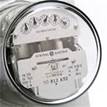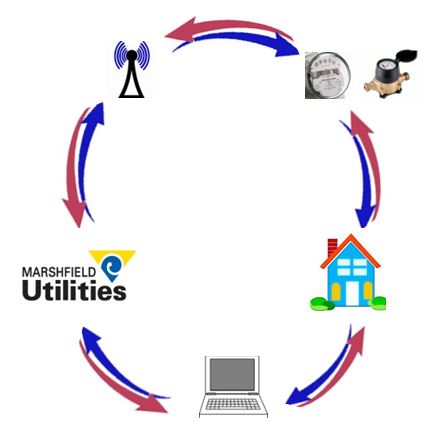Building a intelligent energy future
Technology is changing by the minute. Cell phones, computers, cars – and even technology used in the utility industry.
Grid Modernization involves the use of intelligent devices and systems to support more efficient and reliable delivery of electricity using digital technology. Grid Modernization provides tools to help save energy, reduce costs, and increase reliability.


Marshfield Utilities plans to undertake some Grid Modernization-related initiatives as they are cost-effective and will enhance utility infrastructure. One of our most visible and extensive Grid Modernization projects will be the deployment of Advanced Metering Infrastructure (AMI) smart metering technology throughout our service territory. We view AMI as a key part of our Grid Modernization efforts.
Advantages of Grid Modernization technologies
The four key drivers for Marshfield Utilities’ Grid Modernization strategy are:
-
Improving the utility’s efficiency in customer service and billing activities, emergency response, and load management.
-
Maintaining reliability of aging infrastructure and improving efficiency and capacity of the grid through enhanced asset management, monitoring, and self-healing capabilities.
-
Preparing the grid for integration of renewable and distributed energy resources, such as from wind, solar, bio-gas, and plug-in hybrid electric vehicles.
-
Enabling active consumer participation in managing energy usage and costs through energy efficiency and demand response to shift peak loads.
Wondering how AMI works or what the benefits of it are, or how it relates to Grid Modernization? Keep reading to learn more.
How AMI Works

Electric and water meters are read remotely through communications towers. This usage information is then transmitted to Marshfield Utilities via a fixed radio frequency network where it is then used in our billing, customer service and outage notification systems.
Benefits of AMI
Current:
- Reduces estimated bills and meter reading errors
- Reduces need to access customer property
- Ability to monitor energy theft
- Reduces miles driven resulting in less fuel consumption and lower vehicle emissions
Future:
- New and improved rate options and programs
- Improve power outage identification and restoration response
- Online information to better manage your energy usage and costs
Frequently asked Grid Modernization questions
What is Grid Modernization?
Grid Modernization is the use of intelligent devices and systems to support more efficient and reliable delivery of electricity from suppliers to consumers using digital technology. Grid Modernization systems provide tools to help save energy, reduce costs, and increase reliability.
What is AMI?
Advanced Metering Infrastructure (AMI) technology uses remote two-way wireless communication to retrieve customer energy usage information at frequent intervals from customers’ electric smart meters and/or water meters via a Radio Frequency (RF) fixed network. A Meter Data Management System receives and houses the data for analysis and use by other systems such as customer information and billing, load research, and delivery system planning.
How does AMI relate to Grid Modernization?
For Marshfield Utilities, and most other utilities, AMI is considered to be the foundational building block for Grid Modernization. Its two-way communication capabilities serve as a platform for enhanced customer engagement and tools to gain a better understanding of their energy usage, and for monitoring the performance and status of the electric delivery system. Our AMI system will also provide a cost-effective communications path to enable deployment of equipment and devices that enhance reliability and efficient operation of the electric delivery system.
Why is Marshfield Utilities implementing AMI technology?
AMI lays the groundwork for partnering with our customers to build a smarter energy future. This technology and the future opportunities it presents will empower customers by providing the insight and tools needed to better manage their own energy usage and create opportunities for long-term cost savings, while also creating operational efficiencies.
What type of information is being transmitted?
Only meter numbers, energy usage readings and diagnostic information are transmitted. Personal data is not transmitted so customer information will remain private and secure.
How secure is the information being sent from the customer’s meter to Marshfield Utilities?
The AMI communications system uses a multi-layered approach to securing data that makes the data very secure.
Are these new smart meters accurate?
Yes. All of the AMI meters are tested for accuracy at the factory, using calibrated reference standards that provide reproducible and verifiable results. While it’s not required, we will also sample test shipments of meters received as a secondary check prior to approving meters for installation.
What frequency does the AMI technology use?
The AMI system operates under a Federal Communications Commission (FCC) license and uses a portion of the 900 MHz radio frequency band separate from that commonly used by consumer products such as cordless telephones and garage door openers. Because of this, the AMI system will not cause interference problems with other wireless devices.
Are there any potential health concerns with the Radio Frequency (RF) signals?
Several studies have been done on low-power RF transmissions, but no negative health impacts have been found. The AMI system Marshfield Utilities will deploy meets all applicable FCC requirements. AMI enabled electric and water meters only transmit four to six times per day and use very short micro-second bursts of data when doing so. When compared to other common consumer wireless devices such as cordless or mobile phones, the output is substantially lower.
Additional Information
More information can be found by clicking this link to the Smart Grid Consumer Collaborative Website.



